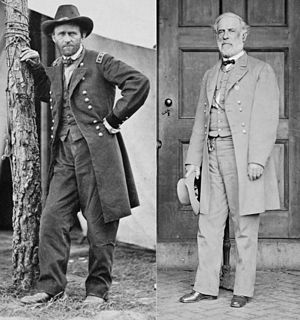
Back حملة أوفرلاند Arabic Overland-kampagnen Danish Überland-Feldzug German Campaña de Overland Spanish کمپین اوورلند Persian Overland Campaign French Campagna terrestre Italian オーバーランド方面作戦 Japanese Expeditio Terrestris Latin Overlandveldtocht Dutch
| Overland Campaign | |||||||
|---|---|---|---|---|---|---|---|
| Part of the American Civil War | |||||||
 Ulysses S. Grant and Robert E. Lee, respectively, opposing commanders in the Overland Campaign | |||||||
| |||||||
| Belligerents | |||||||
|
|
| ||||||
| Commanders and leaders | |||||||
|
Ulysses S. Grant George G. Meade | Robert E. Lee | ||||||
| Units involved | |||||||
| Army of Northern Virginia | |||||||
| Strength | |||||||
| 103,875[7]–124,232 ("present for duty")[8][9] | 60,000–65,000[10] | ||||||
| Casualties and losses | |||||||
|
54,926 total (7,621 killed; 38,339 wounded; 8,966 captured/missing)[11][12] |
30,000–35,000 (estimated)[12] | ||||||
The Overland Campaign, also known as Grant's Overland Campaign and the Wilderness Campaign, was a series of battles fought in Virginia during May and June 1864, towards the end of the American Civil War. Lt. Gen. Ulysses S. Grant, general-in-chief of all Union armies, directed the actions of the Army of the Potomac, commanded by Maj. Gen. George G. Meade, and other forces against Confederate Gen. Robert E. Lee's Army of Northern Virginia. Although Grant suffered severe losses during the campaign, it was a strategic Union victory. It inflicted proportionately higher losses on Lee's army and maneuvered it into a siege at Richmond and Petersburg, Virginia, in just over eight weeks.
Crossing the Rapidan River on May 4, 1864, Grant sought to defeat Lee's army by quickly placing his forces between Lee and Richmond and inviting an open battle. Lee surprised Grant by attacking the larger Union army in the Battle of the Wilderness (May 5–7), resulting in many casualties on both sides. Unlike his predecessors in the Eastern Theater, Grant did not withdraw his army following this setback but instead maneuvered to the southeast, resuming his attempt to interpose his forces between Lee and Richmond; Lee's army was able to get into position to block this maneuver. At the Battle of Spotsylvania Court House (May 8–21), Grant repeatedly attacked segments of the Confederate defensive line, hoping for a breakthrough but the only results were again many losses for both sides.
Grant maneuvered again, meeting Lee at the North Anna River (Battle of North Anna, May 23–26). Here, Lee held clever defensive positions that provided an opportunity to defeat portions of Grant's army but illness prevented Lee from attacking in time to trap Grant. The final major battle of the campaign was waged at Cold Harbor (May 31 – June 12), in which Grant gambled that Lee's army was exhausted and ordered a massive assault against strong defensive positions, resulting in disproportionately heavy Union casualties. Resorting to maneuver a final time, Grant surprised Lee by stealthily crossing the James River, threatening to capture the city of Petersburg, the loss of which would doom the Confederate capital. The resulting siege of Petersburg (June 1864 – April 1865) led to the eventual surrender of Lee's army in April 1865 and the end of the Civil War.
The campaign included two long-range raids by Union cavalry under Maj. Gen. Philip Sheridan. In a raid toward Richmond, Confederate cavalry commander Maj. Gen. J.E.B. Stuart was mortally wounded at the Battle of Yellow Tavern (May 11). In a raid attempting to destroy the Virginia Central Railroad to the west, Sheridan was thwarted by Maj. Gen. Wade Hampton at the Battle of Trevilian Station (June 11–12), the largest cavalry battle of the war.
- ^ Gordon Rhea, Onto Petersburg, (Baton Rouge: LSU Press, 2017), 334.
- ^ "The Overland Campaign of 1864". 14 April 2014.
- ^ Further information:
Organization of the forces operating against Richmond, on the morning of May 5, 1864: Official Records, Series I, Volume XXXVI, Part 1, pages 106–116;
Organization of Army of the Potomac, May 31, 1864: Official Records, Series I, Volume XXXVI, Part 1, pages 198–209. - ^ This Army Corps was under direct orders of Lieut. Gen. Ulysses S. Grant until May 24, 1864, when it was assigned to the Army of the Potomac. See: Official Records, Series I, Volume XXXVI, Part 1, page 113 (note at the bottom of the page).
- ^ June 2–15, 1864: temporarily attached to the Army of the Potomac from the Army of the James (and engaged at Cold Harbor only). See: Official Records, Series I, Volume XXXVI, Part 1, page 178 (note at the bottom of the page).
- ^ Further information:
Army of the James (in the field), on the morning of May 5, 1864: Official Records, Series I, Volume XXXVI, Part 1, pages 116–119. - ^ Field return of the Army of the Potomac for June 1, 1864 (Official Records, Series I, Volume XXXVI, Part 1, page 209).
- ^ "Present for duty" (April 30, 1864): Army of the Potomac: 102,869; IX Army Corps: 21,363. See Abstract from tri-monthly return of the Army of the Potomac, Maj. Gen. George G. Meade, U.S. Army commanding, April 30, 1864 (Official Records, Series I, Volume XXXVI, Part 1, page 198) and Abstract from return of the Ninth Army Corps, commanded by Maj. Gen. Ambrose E. Burnside, U.S. Army, for April 30, 1864 (Official Records, Series I, Volume XXXVI, Part 1, page 915).
- ^ 118,700: according to Eicher, p. 660.
- ^ 64,000: according to Eicher, p. 660.
- ^ General summary from the Rapidan to the James River, May 5 – June 24, 1864: Official Records, Series I, Volume XXXVI, Part 1, page 188.
- ^ a b Further information: see also Aftermath for widely varying casualty estimates.
© MMXXIII Rich X Search. We shall prevail. All rights reserved. Rich X Search